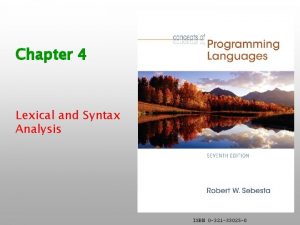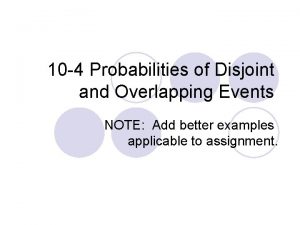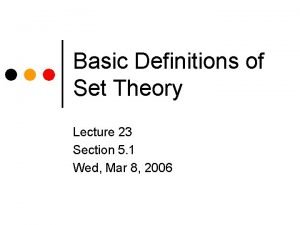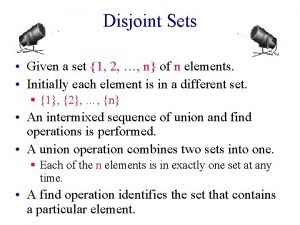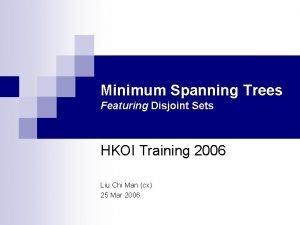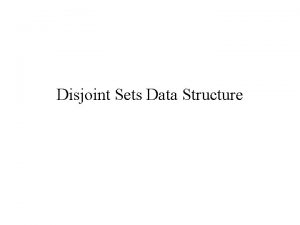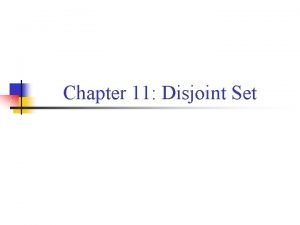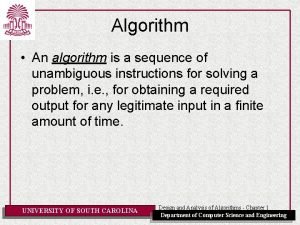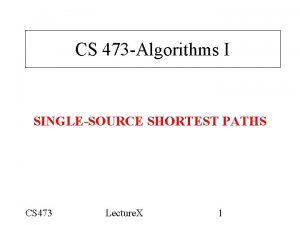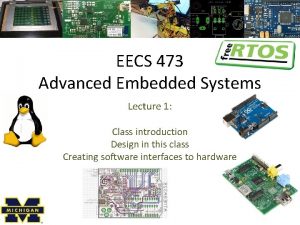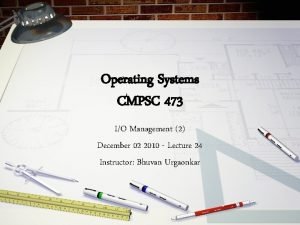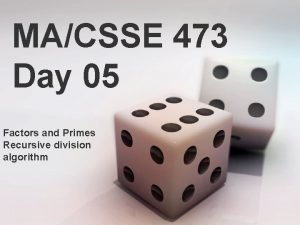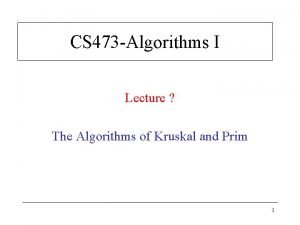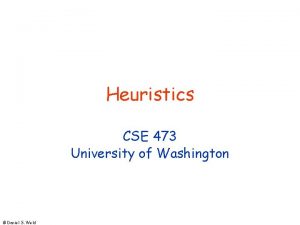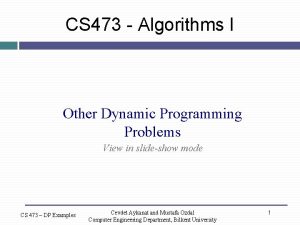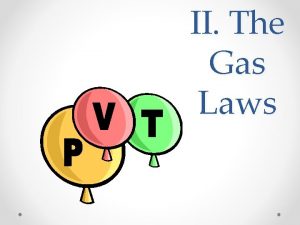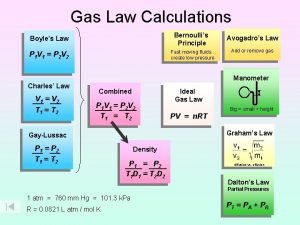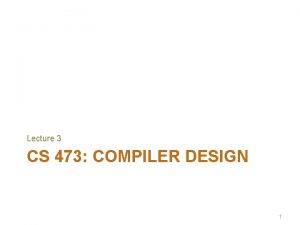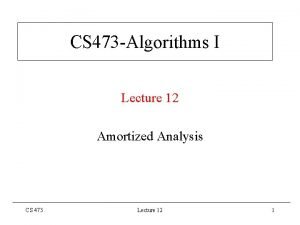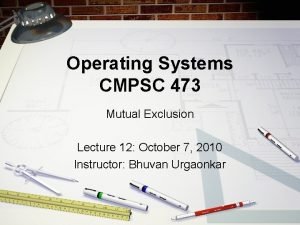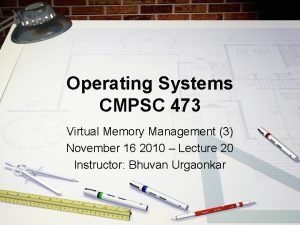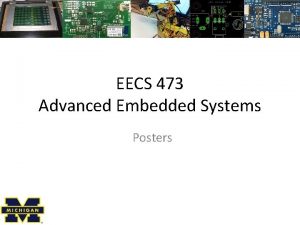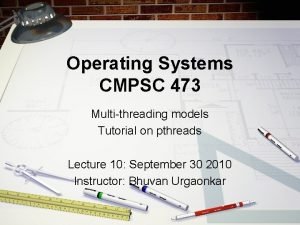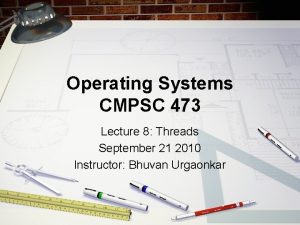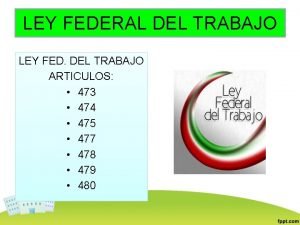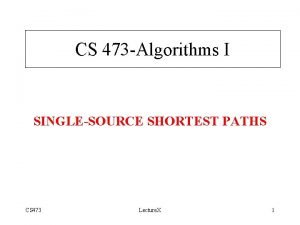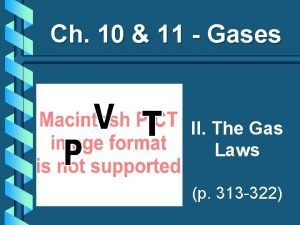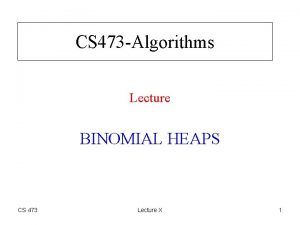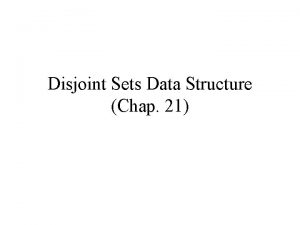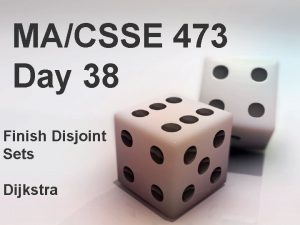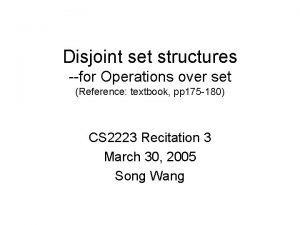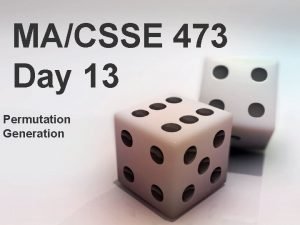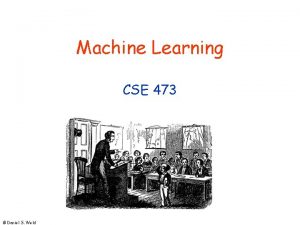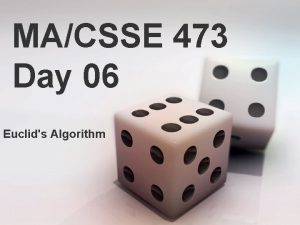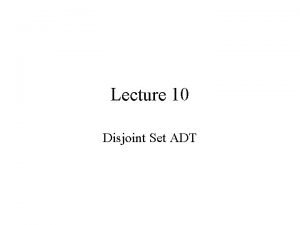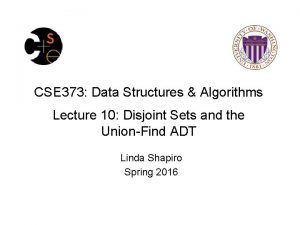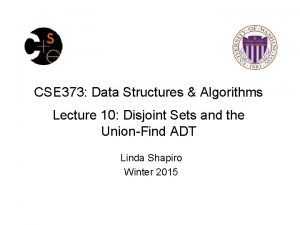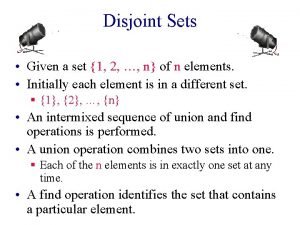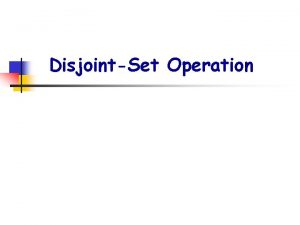CS 473 Algorithms I Lecture X Disjoint Set









































![Pseudocodes For the Heuristics Implementation of UNION-BY-RANK Heuristic p[x] : Pointer to the parent Pseudocodes For the Heuristics Implementation of UNION-BY-RANK Heuristic p[x] : Pointer to the parent](https://slidetodoc.com/presentation_image_h/d951a36be9509f21c85460e9198bf974/image-42.jpg)


- Slides: 44

CS 473 -Algorithms I Lecture X Disjoint Set Operations CS 473 Lecture X 1

Disjoint Set Operations A disjoint-set data structure • Maintains a collection of disjoint dynamic sets • Each set is identified by a representative which is some member of the set In some applications, • It doesn't matter which member is used as the representative • We only care that, Ø if we ask for the representative of a set twice without modifying the set between the requests, Pwe get the same answer both times CS 473 Lecture X 2

Disjoint Set Operations In other applications, There may be a prescribed rule for choosing the representative E. G. Choosing the smallest member in the set Each element of a set is represented by an object “x” MAKE-SET(x) creates a new set whose only member is x – Object x is the representative of the set – x is not already a member of any other set UNION(x, y) unites the dynamic sets that contain x&y – are assumed to be disjoint prior to the operation – The new representative is some member of CS 473 Lecture X 3

Disjoint Set Operations – Usually, the representative of either the new representative is chosen as We destroy sets , removing them from the collection since we require the sets in the collection to be disjoint FIND-SET(x) returns a pointer to the representative of the unique set containing x We will analyze the running times in terms of two parameters Ø n : The number of MAKE-SET operations Ø m : The total number of MAKE-SET, UNION and FIND-SET operations CS 473 Lecture X 4

Disjoint Set Operations • Each union operation reduces the number of sets by one since the sets are disjoint Ø Therefore, only one set remains after n - 1 union operations Ø Thus, the number of union operations is n– 1 • Also note that, m n always hold since MAKE-SET operations are included in the total number of operations CS 473 Lecture X 5

An Application of Disjoint-Set Data Structures Determining the connected components of an undirected graph G=(V, E) CONNECTED-COMPONENTS (G) for each vertex v V[G] do MAKE-SET(v) endfor each edge (u, v) E[G] do if FIND-SET(u) FIND-SET(v) then UNION(u, v) endif endfor end SAME-COMPONENT(u, v) if FIND-SET(u) = FIND-SET(v) then return TRUE else return FALSE endif end CS 473 Lecture X 6

An Application of Disjoint-Set Data Structures Determining the connected components of an undirected graph G=(V, E) a b e c d g Initial {a} CS 473 {b} h f j i {c} {d} {e} Lecture X {f} {g} {h} {i} {j} 7

An Application of Disjoint-Set Data Structures Determining the connected components of an undirected graph G=(V, E) a b e c d g h f i Initial {a} {b} (b, d) {a} {b, d} {c} CS 473 j {c} {d} {e} {f} {g} {h} {i} {j} Lecture X 8

An Application of Disjoint-Set Data Structures Determining the connected components of an undirected graph G=(V, E) a b e c d g Initial {a} {b} (b, d) (e, g) h f j i {e} {f} {g} {h} {i} {j} {a} {b, d} {c} {e} {f} {g} {h} {i} {j} {a} {e, g} {f} {h} {i} {j} CS 473 {c} {b, d} {c} {d} Lecture X 9

An Application of Disjoint-Set Data Structures Determining the connected components of an undirected graph G=(V, E) a b e c d g Initial {a} {b} (b, d) (e, g) (a, c) h f j i {e} {f} {g} {h} {i} {j} {a} {b, d} {c} {a, c} {b, d} {e, g} {f} CS 473 {c} {d} Lecture X {h} {i} {j} 10

An Application of Disjoint-Set Data Structures Determining the connected components of an undirected graph G=(V, E) a b e c d g Initial {a} {b} (b, d) (e, g) (a, c) (h, i) h f j i {e} {f} {g} {h} {i} {j} {a} {b, d} {c} {a, c} {b, d} {e, g} {f} CS 473 {c} {d} Lecture X {h} {i} {j} {h, i} {j} 11

An Application of Disjoint-Set Data Structures Determining the connected components of an undirected graph G=(V, E) a b e c d g h f i Initial {a} {b} (b, d) {a} {b, d} {c} (e, g) (a, c) (h, i) (a, b) {a} {b, d} {c} {a, c} {b, d} {a, b, c, d} CS 473 j {c} {d} {e} {f} {g} {h} {i} {j} {e, g} {f} {f} Lecture X {h} {i} {h, i} {j} {j} 12

An Application of Disjoint-Set Data Structures Determining the connected components of an undirected graph G=(V, E) a b e c d g h f i Initial {a} {b} (b, d) {a} {b, d} {c} (e, g) (a, c) (h, i) (a, b) (e, f) {a} {b, d} {c} {a, c} {b, d} {a, b, c, d} CS 473 j {c} {d} {e} {f} {g} {h} {i} {j} {e, g} {f} {e, f, g} Lecture X {h} {i} {h, i} {j} {j} {j} 13

An Application of Disjoint-Set Data Structures Determining the connected components of an undirected graph G=(V, E) a b e c d g h f i Initial {a} {b} (b, d) {a} {b, d} {c} (e, g) (a, c) (h, i) (a, b) (e, f) (b, c) {a} {b, d} {c} {a, c} {b, d} {a, b, c, d} CS 473 j {c} {d} {e} {f} {g} {h} {i} {j} {e, g} {f} {e, f, g} Lecture X {h} {i} {h, i} {j} {j} {j} 14

Linked-List Representation of Disjoint Sets • • Represent each set by a linked-list The first object in the linked-list serves as its set representative • Each object in the linked-list contains i. A set member ii. A pointer to the object containing the next set member iii. A pointer back to the representative Representative pointer MAKE-SET(x) : O(1) x Next Object Pointer / FIND-SET(x) : We return the representative pointer of x CS 473 Lecture X 15

Linked-List Representation of Disjoint Sets A Simple Implementation of Union : UNION(c, y) – APPEND x's list to the end of y 's list – The representative of y 's list becomes the new representative – UPDATE the representative pointer of each object originally on x's list which takes time linear in the length of x's list c 's list • • / • NIL y 's list CS 473 • • Lecture X • 16

Linked-List Representation of Disjoint Sets A Simple Implementation of Union : UNION(c, y) c 's • list • • • / • NIL y 's list • • CS 473 Lecture X • • • / 17

Analysis of the Simple Union Implementation • A sequence of m operations that requires • Suppose that we have n objects Operation MAKE-SET(c 1) CS 473 Number of Objects Updated 1 P {c } time and let m = 2 n - 1 Updated Objects (Denoted By ‘P’) 1 Lecture X 18

Analysis of the Simple Union Implementation Operation MAKE-SET(c 1) MAKE-SET(c 2) CS 473 Number of Objects Updated 1 1 {c. P 1} {c 2 P } Lecture X Updated Objects (Denoted By ‘P’) 19

Analysis of the Simple Union Implementation Operation MAKE-SET(c 1) MAKE-SET(c 2). . . CS 473 Number of Objects Updated 1 1 {c. P 1} {c 2 P } Updated Objects (Denoted By ‘P’) . . . Lecture X 20

Analysis of the Simple Union Implementation Operation MAKE-SET(c 1) MAKE-SET(c 2). . . MAKE-SET(cn) CS 473 Number of Objects Updated 1 1. . . 1 {c. P 1} {c 2 P } Updated Objects (Denoted By ‘P’) P { c n} Lecture X 21

Analysis of the Simple Union Implementation Operation MAKE-SET(c 1) MAKE-SET(c 2). . . Number of Objects Updated 1 1. . . {c. P 1} {c 2 P } MAKE-SET(cn) 1 P c { } UNION(c 1, c 2) 1 { c 1} CS 473 Updated Objects (Denoted By ‘P’) n Lecture X {c 2} c {c. P 1, 2} 22

Analysis of the Simple Union Implementation Operation MAKE-SET(c 1) MAKE-SET(c 2). . . MAKE-SET(cn) UNION(c 1, c 2) UNION(c 2, c 3) CS 473 Number of Objects Updated 1 1. . . {c. P 1} {c 2 P } Updated Objects (Denoted By ‘P’) P 1 { c n} 1 { c 1} 2 {c 1, c 2} Lecture X {c 2} {c 3} P c { 1, c 2} c. Pc } {c. P 1, 2, 3 23

Analysis of the Simple Union Implementation Operation MAKE-SET(c 1) MAKE-SET(c 2). . . Number of Objects Updated 1 1. . . Updated Objects (Denoted By ‘P’) {c. P 1} {c 2 P } P MAKE-SET(cn) 1 { c n} UNION(c 1, c 2) 1 { c 1} 2 {c 1, c 2} 3 {c 1, c 2, c 3} UNION(c 2, c 3) UNION(c 3, c 4) CS 473 Lecture X c c } {P 1, 2 {c 2} {c 3} {c 4} c c c } {PP 1, 2, 3 PPP {c 1, c 2, c 3, c 4} 24

Analysis of the Simple Union Implementation Operation MAKE-SET(c 1) MAKE-SET(c 2). . . Number of Objects Updated 1 1. . . Updated Objects (Denoted By ‘P’) {c. P 1} {c 2 P } 1 c } {P n UNION(c 1, c 2) 1 { c 1} UNION(c 2, c 3) 2 {c 1, c 2} UNION(c 3, c 4) 3 {c 1, c 2, c 3} MAKE-SET(cn) . . CS 473 . . Lecture X P {c 2} {c 1, c 2} {c 3} {c 4} c c c } {PP 1, 2, 3 c c c {c. PPP 1, 2, 3, 4} 25

Analysis of the Simple Union Implementation Operation MAKE-SET(c 1) MAKE-SET(c 2). . . Number of Objects Updated 1 1. . . {c. P 1} {c 2 P } 1 c } {P n UNION(c 1, c 2) 1 { c 1} UNION(c 2, c 3) 2 UNION(c 3, c 4) 3 MAKE-SET(cn) . . UNION(c c n-1, n) CS 473 . . n-1 Updated Objects (Denoted By ‘P’) P PP {c 1, c 2} {c 3} {c 1, c 2, c 3} PPP {c c c } {c 2} 1, 2, 3 {c 1, c 2, . . , cn-1} Lecture X {c 1, c 2} 4 1, 2, 3, 4 {cn} {c 1, c 2, . . , cn-1, cn, } PP P 26

Analysis of the Simple Union Implementation • The total number of representative pointer updates MAKE-SET operations UNION operations since Ø Thus, on the average, each operation requires Q(m) time Ø That is, the amortized time of an operation is Q(m) CS 473 Lecture X 27

A Weighted-Union Heuristic • The simplementation is inefficient because Ø We may be appending a longer list to a shorter list during a UNION operation so that we must update the representative pointer of each member of the longer list Weighted Union Heuristic – Maintain the length of each list – Always append the smaller list to the longer list With ties broken arbitrarily ‼ A single UNION can still take (m) time if both sets have (m) members CS 473 Lecture X 28

Weighted Union Heuristic Theorem: A sequence of m MAKE-SET, UNION & FINDSET operations, n of which are MAKE-SET operations, takes O(m+nlgn) time Proof: Try to compute an upper bound on the number of representative pointer updates for each object in a set of size n Consider a fixed object x – Each time x’s R-PTR was updated, x was a member of the smaller set P {x} {v}→ { c , v} 1 -st update |Sx| 2 P {x, v} {w 1, w 2} → { c , P v , w 1, w 2} 2 -nd update |Sx| 4 {x, v, w } {z , z , z } → { P , w , z , z }; |S | 4 c , v. PPP 1 2 3 -rd update |S| CS 473 1 2 3 4 x 8 Lecture X 29

Weighted Union Heuristic • For any k n, after x’s R-PTR has been updated times the resulting set must have at least k members Ø R-PTR of each object can be updated at most time over all UNION operations Analysis of The Weighted-Union Heuristic • The figure below illustrates a worst case sequence for a set with n = 16 objects • The total number of R-PTR updates lg n CS 473 Lecture X 30

Analysis of The Weighted-Union Heuristic 1 2 CS 473 3 4 5 6 7 8 9 Lecture X 1 0 1 1 1 2 1 3 1 4 1 5 1 6 31

Analysis of The Weighted-Union Heuristic 1 , 2 1 2 CS 473 3 , 4 3 4 5, 6 5 6 7, 8 7 8 9 , 10 9 Lecture X 1 0 11 , 12 1 1 1 2 13 , 14 1 3 1 4 15 , 16 1 5 1 6 32

Analysis of The Weighted-Union Heuristic 1 , 2 , 3, 4 1 , 2 1 2 CS 473 5 , 6 , 7, 8 3 , 4 3 4 5, 6 5 6 9 , 10 , 11, 12 7, 8 7 8 9 , 10 9 Lecture X 1 0 11 , 12 1 1 1 2 13 , 14 , 15, 13 , 14 1 3 1 4 16 15 , 16 1 5 1 6 33

Analysis of The Weighted-Union Heuristic 9 , 10 , 11 , 12 , 13, 14, 15, 16 1 , 2 , 3 , 4 , 5, 6, 7, 8 1 , 2 , 3, 4 1 , 2 1 2 CS 473 5 , 6 , 7, 8 3 , 4 3 4 5, 6 5 6 9 , 10 , 11, 12 7, 8 7 8 9 , 10 9 Lecture X 1 0 11 , 12 1 1 1 2 13 , 14 , 15, 13 , 14 1 3 1 4 16 15 , 16 1 5 1 6 34

Analysis of The Weighted-Union Heuristic 1 , 2 , 3 , 4 , 5 , 6 , 7 , 8 , 9, 10, 11, 12, 13, 14, 15, 16 9 , 10 , 11 , 12 , 13, 14, 15, 16 1 , 2 , 3 , 4 , 5, 6, 7, 8 1 , 2 , 3, 4 1 , 2 1 2 CS 473 5 , 6 , 7, 8 3 , 4 3 4 5, 6 5 6 9 , 10 , 11, 12 7, 8 7 8 9 , 10 9 Lecture X 1 0 11 , 12 1 1 1 2 13 , 14 , 15, 13 , 14 1 3 1 4 16 15 , 16 1 5 1 6 35

Analysis of The Weighted-Union Heuristic • Each MAKE-SET & FIND-SET operation takes O(1) time, and there are O(m) of them Ø The total time for the entire sequence = O(m + nlgn) Disjoint Set Forests In a faster implementation, we represent sets by rooted trees – Each node contains one member – Each tree represents one set – Each member points only to its parent – The root of each tree contains the representative – Each root is its own parent CS 473 Lecture X 36

Disjoint Set Forests x 1 x 2 x 4 y 1 x 3 y 2 UNION(x, y) x 2 y 3 y 2 x 1 y 3 x 4 CS 473 Lecture X 37

Disjoint Set Forests Straightforward Implementation MAKE-SET : Simply creates a tree with just one node : O(1) FIND-SET : Follows parent pointers until the root node is found The nodes visited on this path toward the root constitute the FIND-PATH UNION : Makes the root of one tree to point to the other one Heuristics To Improve the Running Time • Straightforward implementation is no faster than ones that use the linked-list representation • A sequence of n – 1 UNIONs, following a sequence of n MAKE-SETs, may create a tree, which is just a linear chain of n nodes CS 473 Lecture X 38

Heuristics To Improve the Running Time First Heuristic : UNION by Rank • Similar to the weighted-union used for the linked-list representation • The idea is to make the root of the tree with fewer nodes point to the root of the tree with more nodes • Rather than explicitly keeping the size of the subtree rooted at each node We maintain a rank – that approximates the logarithm of the subtree size – and is also an upperbound on the height of the node • During a UNION operation – make the root with smaller rank to point to the root with larger rank CS 473 Lecture X 39

Heuristics To Improve the Running Time Second Heuristic : Path Compression • Use it during the FIND-SET operations • Make each node on the FIND-PATH to point directly to the root f e d c b a CS 473 FIND-SET(b) Lecture X 40

Heuristics To Improve the Running Time Path Compression During FIND-SET(b) Operation f b c d e a CS 473 Lecture X 41
![Pseudocodes For the Heuristics Implementation of UNIONBYRANK Heuristic px Pointer to the parent Pseudocodes For the Heuristics Implementation of UNION-BY-RANK Heuristic p[x] : Pointer to the parent](https://slidetodoc.com/presentation_image_h/d951a36be9509f21c85460e9198bf974/image-42.jpg)
Pseudocodes For the Heuristics Implementation of UNION-BY-RANK Heuristic p[x] : Pointer to the parent of the node x rank[x] : An upperbound on the height of node x in the tree MAKE-SET(x) p[x] ← x rank[x] ← 0 end UNION(x, y) LINK(FIND-SET(x), FIND-SET(y)) end LINK(x, y) if rank[x] > rank[y] then p[y] ← x else p[x] ← y if rank[x] = rank[y] then rank[y] = rank[y] + 1 endif end CS 473 Lecture X 42

Implementation of UNION-BY-RANK Heuristic – When a singleton set is created by a MAKE-SET the initial rank of the single node in the tree is zero – Each FIND-SET operation leaves all ranks unchanged – When applying a UNION to two trees, we make the root of tree with higher rank the parent of the root of lower rank Ties are broken arbitrarily CS 473 Lecture X 43

Implementation of the Path-Compression Heuristic The FIND-SET procedure with Path-Compression Iterative Version FIND-SET(x) y←x while y p[y] do y ← p[y] endwhile root ← y while x p[x] do parent ← p[x] ← root x ← parent endwhile return root end CS 473 Recursive Version FIND-SET(x) if x p[x] then p[x] ← FIND-SET(p[x]) endif return p[x] end Lecture X 44
 Pairwise disjointness test
Pairwise disjointness test Disjoint event example
Disjoint event example Total set awareness set consideration set
Total set awareness set consideration set Training set validation set test set
Training set validation set test set Disjoint set
Disjoint set Ackermann function complexity
Ackermann function complexity Union by rank
Union by rank Proper subset symbol
Proper subset symbol Dynamic equivalence problem in data structures
Dynamic equivalence problem in data structures Java disjoint set
Java disjoint set Disjoint set adt
Disjoint set adt Disjointed maze generator
Disjointed maze generator Outline节点
Outline节点 Introduction to algorithms lecture notes
Introduction to algorithms lecture notes Analysis of algorithms lecture notes
Analysis of algorithms lecture notes Unambiguous in algorithm
Unambiguous in algorithm 01:640:244 lecture notes - lecture 15: plat, idah, farad
01:640:244 lecture notes - lecture 15: plat, idah, farad Cs 473
Cs 473 Eecs 473
Eecs 473 Round 236 to the nearest ten
Round 236 to the nearest ten Cmpsc 473
Cmpsc 473 Factors of 473
Factors of 473 Nuvw
Nuvw Kruskal algorithm in c
Kruskal algorithm in c A gas occupies 473 cm3 at 36°c. find its volume at 94°c
A gas occupies 473 cm3 at 36°c. find its volume at 94°c Uw cse 473
Uw cse 473 Bilkent cs473
Bilkent cs473 Pv=pv law
Pv=pv law A gas occupies 473 cm3 at 36°c. find its volume at 94°c
A gas occupies 473 cm3 at 36°c. find its volume at 94°c Cs 473
Cs 473 Cs 473
Cs 473 Cmpsc 473
Cmpsc 473 Cmpsc 473
Cmpsc 473 Join point
Join point K=pv
K=pv Eecs 473
Eecs 473 Cmpsc 473
Cmpsc 473 Eecs 473
Eecs 473 Characteristics of gases
Characteristics of gases Cmpsc 473
Cmpsc 473 Ley federal del trbajo
Ley federal del trbajo Cs 473
Cs 473 A gas occupies 473 cm3 at 36°c. find its volume at 94°c
A gas occupies 473 cm3 at 36°c. find its volume at 94°c Cs 473
Cs 473 Crisp set vs fuzzy set
Crisp set vs fuzzy set
